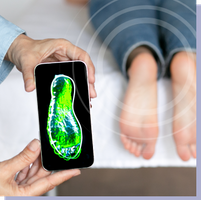What is chronic pain and how is it treated?
Chronic pain is a complex health issue that affects millions of people around the world. It’s more than just a physical sensation; it can affect your emotional health and overall quality of life. Let’s take a deeper look at this condition.
Chronic pain is a type of pain that lasts or recurs for more than three months. Unlike acute pain, which is a normal response to injury or illness, chronic pain continues long after the body has healed. It can occur in any part of the body and can range in intensity, from mild to severe. It is important to note that chronic pain is not just a symptom, but a disease in itself.
Chronic pain can be difficult to diagnose because it is not always associated with an obvious injury or health condition. It is often the result of changes in the nervous system that continue to send pain signals to the brain, even when there is no ongoing tissue damage. This type of pain can be very challenging to manage and can significantly impact a person’s daily life and mental health.
Prevalence of chronic pain conditions
Chronic pain is a widespread issue. According to the Centers for Disease Control and Prevention (CDC), about 20% of adults in the United States, or about 50 million people, suffered from chronic pain in 2016. Chronic pain conditions can include arthritis, fibromyalgia, migraines, and back pain, among others. These statistics highlight the importance of understanding and addressing chronic pain.
In the following sections, we will explore the symptoms, causes, diagnosis, and treatment of chronic pain, as well as strategies for managing and living with it. Our goal is to provide comprehensive information to help those with chronic pain and their loved ones better understand and cope with this condition.
Chronic pain symptoms
Chronic pain is a complex condition that can be difficult to understand. But, it’s important to know the symptoms so you can get the help you need. Let’s break down the symptoms into three categories: physical symptoms, psychological symptoms, and impact on daily life.
Physical symptoms
Physical symptoms are the most obvious signs of chronic pain. These can vary greatly from person to person, but often include:
Persistent pain: This is pain that does not go away, even after the injury has healed.
Increased sensitivity: You may find that ordinary touch or pressure causes pain, or that things that used to hurt a little now hurt a lot.
Reduced mobility: Chronic pain can make movement difficult, leading to muscle stiffness and weakness.
Psychological symptoms
Chronic pain doesn’t just affect the body, it also affects the mind. Some of the psychological symptoms of chronic pain include:
Depression and anxiety: Living with constant pain can lead to feelings of sadness, hopelessness, and worry.
Difficulty concentrating: Pain can make it difficult to focus on tasks or remember things.
Insomnia: Pain can make it difficult to sleep, leading to fatigue.
Impact on daily life: Chronic pain can have a big impact on your daily life. It can affect your ability to do things you enjoy and even simple tasks can become difficult. Here are some ways chronic pain can affect your daily life:
Work: Pain can make it difficult to concentrate, which can affect your performance at work.
Social life: Pain can make it difficult to take part in social activities, leading to feelings of isolation.
Self-care: Even basic tasks like cooking, cleaning, and personal hygiene can be difficult when you are in pain.
Remember, everyone’s experience with chronic pain is different. If you are experiencing any of these symptoms, it is important to talk to a professional. They can help you find ways to manage your pain and improve your quality of life.
Causes of chronic pain
Chronic pain is a complex condition that can be caused by a variety of factors. Understanding the root cause of your pain is key to finding effective treatment. Here are some common causes of chronic pain:
Injury or Surgery: One of the most common causes of chronic pain is injury. It can be anything from a sprained ankle to a serious car accident. When your body is injured, it sends pain signals to your brain to alert you to the damage. Sometimes, even after the injury has healed, these pain signals continue. This can cause chronic pain. Similarly, surgery can sometimes lead to long-term pain. This is usually due to nerve damage during surgery.
Health condition: Chronic pain can also be caused by a variety of health conditions. For example, conditions like arthritis, fibromyalgia, and migraines can cause ongoing pain. In these cases, the pain is a symptom of the underlying condition. Treating the condition often helps relieve the pain.
Unknown causes: Sometimes, chronic pain can occur for no apparent reason. This can be particularly challenging to treat, as there is no clear source of the pain to target. However, there are still many treatment options available.
Understanding the cause of your pain is the first step toward finding effective treatment. If you experience chronic pain, it’s important to talk to a professional who can help you identify the cause and tailor a treatment plan.
Chronic pain diagnosis
Diagnosing chronic pain involves a comprehensive approach that takes into account various aspects of the patient’s health history and physical condition. Let’s delve deeper into the importance of medical history in diagnosing chronic pain.
Medical history
Understanding a patient’s medical history is a crucial step in diagnosing chronic pain. This includes information about previous injuries or surgeries and existing health conditions.
Previous injuries or surgeries
Previous injuries or surgeries can often be the primary cause of chronic pain. For example, a person who has undergone major surgery may experience ongoing pain at the site of the surgery. Similarly, an old injury that has not healed properly can lead to ongoing discomfort. Therefore, it is essential for doctors to know about any past injuries or surgeries in order to accurately diagnose chronic pain.
Pre-existing health conditions
Pre-existing health conditions can also contribute to chronic pain. Conditions such as arthritis, fibromyalgia , and nerve disorders are known to cause ongoing pain. Additionally, chronic diseases such as diabetes and heart disease can indirectly lead to chronic pain by affecting the body’s ability to heal. Therefore, a thorough understanding of a patient’s health condition is essential in diagnosing chronic pain.
In conclusion, a comprehensive review of a patient’s medical history is a key component in diagnosing chronic pain. It provides important insights into possible causes and helps to build effective treatment strategies.
Physical Examination In diagnosing chronic pain, a physical examination is a crucial step. It includes two key components: observation and testing. Let’s delve deeper into each of these components to better understand them.
Monitoring : Your doctor will start by monitoring your physical condition. They will look for any visible signs of pain, such as swelling, redness, or stiffness. They may also watch how you move, walk, and perform daily activities. This can provide important clues about what might be causing your pain.
Tests : Your doctor will perform a series of tests. These tests can range from simple ones, such as checking your reflexes and sensitivity to touch, to more complex ones, such as checking your muscle strength and range of motion. The tests help your doctor assess the severity of your pain and pinpoint its exact location.
Remember, a physical exam isn’t just about finding the cause of your pain. It’s also about understanding how your pain is affecting your life. So, it’s important to be open and honest with your doctor about your symptoms and how they’re affecting your daily activities.
With the help of a thorough physical examination, your doctor can get a clear picture of your condition and devise an appropriate treatment plan to address your chronic pain.
Diagnostic tests: When diagnosing chronic pain, your doctor may use a variety of tests to get a clear picture of what’s causing your discomfort. These tests can help pinpoint the source of your pain and guide the best course of treatment. Let’s take a closer look at some of these diagnostic tests.
Imaging tests: Imaging tests, such as X-rays, MRI scans, and CT scans, can provide a detailed view of the internal structures of your body. These tests can help doctors see if there are any abnormalities, such as fractures, tumors, or inflammation, that may be causing your pain. For example, an X-ray of your back may reveal a herniated disc that is pressing on a nerve and causing pain.
Blood test: Blood tests can be used to check for signs of infection, inflammation, or other medical conditions that may be causing your pain. For example, a high white blood cell count may indicate an infection, while high levels of certain proteins may suggest inflammation. Blood tests can also help rule out certain causes of pain.
Remember, these tests are just tools to help your doctor diagnose your pain. They are not definitive, and your doctor will also consider your symptoms and medical history when making a diagnosis. It is important to communicate openly with your doctor about your pain so that they can provide the best possible treatment.
Chronic pain treatment
Chronic pain can be a challenging condition to live with, but there are a number of treatments available that can help manage symptoms and improve your quality of life. One of the main forms of chronic pain treatment is through medication.
Medications
Medications are often the first line of treatment for chronic pain. They can be divided into two main categories: over-the-counter pain relievers and prescription medications.
Over-the-counter (OTC) pain relievers include over-the-counter medications such as acetaminophen (Tylenol), aspirin, and ibuprofen (Advil, Motrin). These medications can help reduce pain and inflammation. They are generally safe for short-term use, but long-term use can lead to side effects such as upset stomach, liver damage, and kidney problems.
Prescription medications: When OTC medications are ineffective, doctors may prescribe stronger painkillers. These can include opioids, such as morphine and oxycodone, and non-opioid medications, such as certain types of antidepressants and anticonvulsants. Prescription medications can be very effective, but they also come with risks, including the potential for addiction and other serious side effects. Therefore, they should be used under the supervision of a healthcare provider.
It’s important to remember that although medications can help manage chronic pain, they should be used as part of a comprehensive treatment plan that may also include physical therapy, psychotherapy, and alternative therapies.
Treatments
When it comes to treating chronic pain, there are several treatment approaches that can be helpful. Let’s explore some of the following treatments:
Physical therapy: Physical therapy is a common treatment for chronic pain. It involves exercises and movements designed to increase flexibility, strength, and overall mobility. The goal is to reduce pain and improve function. According to a study, about 52% of patients with chronic pain found significant relief after participating in a physical therapy program.
Psychotherapy: Psychotherapy, or talk therapy, can also be an effective way to treat chronic pain. It helps patients understand the psychological aspects of pain and teaches them coping strategies. For example, cognitive behavioral therapy (CBT) is a type of psychotherapy that has been shown to be particularly effective in managing chronic pain. One study found that 59% of patients who underwent CBT experienced a significant reduction in their pain levels.
Alternative Therapies: Alternative therapies include therapies such as acupuncture, massage, yoga, and meditation. These therapies can help manage pain by promoting relaxation and reducing stress. A survey showed that 65% of people with chronic pain have used some type of alternative therapy and found it helpful. However, it is important to note that what works for one person may not work for another. Always consult your doctor before starting a new treatment.
Chronic pain treatment
Self-care is a crucial part of managing chronic pain. This involves taking care of your body by eating a balanced diet, getting enough sleep, and staying hydrated. It’s also important to avoid activities that may make your pain worse.
For example, if you have back pain, you may find it helpful to use a heating pad or take a warm bath. These can help relax your muscles and reduce pain. Similarly, if you have arthritis, you may find it helpful to use a cold compress to reduce inflammation and pain.
Exercise: Exercise is a powerful tool for treating chronic pain. Regular exercise can help strengthen muscles, improve flexibility, and boost mood. It’s important to start slowly and gradually increase your activity level. Always consult your doctor or physical therapist before starting a new exercise routine.
Studies show that people who exercise regularly experience less pain and better overall health. For example, one study found that people with chronic lower back pain who participated in a 12-week exercise program experienced significant reductions in pain and improvements in physical function.
Treating anxiety and stress: Stress can exacerbate chronic pain. Therefore, learn how to cope with stress. Techniques like deep breathing, meditation, and yoga can help reduce stress.
For example, a study found that people with chronic pain who participated in an 8-week mindfulness-based stress reduction program experienced significant reductions in pain and improvements in mood and quality of life.
Methods of coping with pain
Living with chronic pain can be challenging, but with the right treatment, it is possible to manage the pain and maintain a good quality of life. Here are some important aspects to consider:
There are various coping strategies that can help treat chronic pain. One of the most effective is to stay active. Regular exercise can help reduce pain and improve mood. It is important to find a balance between rest and activity. Too much rest can lead to muscle weakness and increased pain, while too much activity can cause pain to flare up. Other treatment methods include relaxation techniques, such as deep breathing and meditation, and cognitive behavioral therapy, which can help change negative thinking patterns that can increase pain.
Support system: A strong support system is essential when living with chronic pain. This can include family, friends, healthcare professionals, and support groups. These people can provide emotional support, help with daily tasks, and offer advice and information. Support groups, in particular, can be a great source of comfort and advice, as they provide a space to share experiences and coping situations with others who are going through the same thing.
Impact on quality of life: Chronic pain can have a significant impact on quality of life. It can affect physical health, mental health, and the ability to perform daily activities. However, with the right care and support, pain can be managed and a good quality of life can be maintained. This may include medication, physical therapy, psychological therapy, and lifestyle changes, such as diet and exercise.
Chronic pain relief and follow-up research
As we conclude our chronic pain research, it is important to consider the current state of pain relief, look ahead to the future of research, and share some final thoughts.
Chronic pain management has come a long way in recent years. Professionals now have a better understanding of the complexities of chronic pain and are equipped with more effective tools to treat it. From over-the-counter medications to physical therapy, acupuncture, and cognitive behavioral therapy, there are many options available to help relieve chronic pain. However, it is important to note that what works for one person may not work for another. Chronic pain is a highly individual experience, and effective treatment often requires a personalized approach.
Looking ahead, there is much hope for the field of chronic pain research. Scientists are constantly exploring new ways to understand and treat chronic pain. For example, research is underway to develop non-addictive pain medications and to understand the genetic factors that may cause chronic pain.
Furthermore, the role of mental health in chronic pain is also being studied. There is a growing recognition that addressing psychological factors can play a significant role in pain management.
In conclusion, while living with chronic pain can be challenging, there are many resources available to help you live with the condition. It’s important to remember that you are not alone, and reaching out for help is a sign of strength, not weakness.









